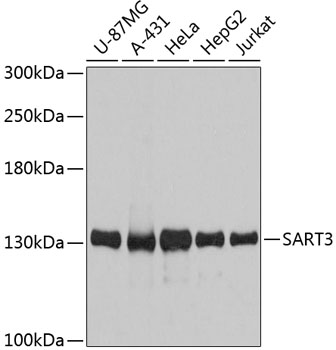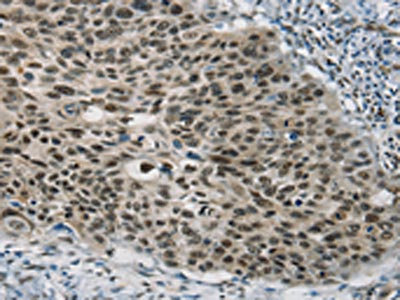SART3 antibody [C3], C-term
GTX107684
ApplicationsImmunoFluorescence, ImmunoPrecipitation, Western Blot, ImmunoCytoChemistry, ImmunoHistoChemistry, ImmunoHistoChemistry Paraffin
Product group Antibodies
TargetSART3
Overview
- SupplierGeneTex
- Product NameSART3 antibody [C3], C-term
- Delivery Days Customer9
- Application Supplier NoteWB: 1:500-1:3000. ICC/IF: 1:100-1:1000. IHC-P: 1:100-1:1000. IP: 1:100-1:500. *Optimal dilutions/concentrations should be determined by the researcher.Not tested in other applications.
- ApplicationsImmunoFluorescence, ImmunoPrecipitation, Western Blot, ImmunoCytoChemistry, ImmunoHistoChemistry, ImmunoHistoChemistry Paraffin
- CertificationResearch Use Only
- ClonalityPolyclonal
- Concentration0.52 mg/ml
- ConjugateUnconjugated
- Gene ID9733
- Target nameSART3
- Target descriptionspliceosome associated factor 3, U4/U6 recycling protein
- Target synonymsDSAP1, P100, RP11-13G14, TIP110, p110, p110(nrb), spliceosome associated factor 3, U4/U6 recycling protein, HIV-1 Tat-interacting protein of 110kDa, PRP24 homolog, SART-3, hSART-3, p110 nuclear RNA-binding protein, squamous cell carcinoma antigen recognized by T cells 3, tat-interacting protein of 110 kDa
- HostRabbit
- IsotypeIgG
- Protein IDQ15020
- Protein NameSpliceosome associated factor 3, U4/U6 recycling protein
- Scientific DescriptionThe protein encoded by this gene is an RNA-binding nuclear protein that is a tumor-rejection antigen. This antigen possesses tumor epitopes capable of inducing HLA-A24-restricted and tumor-specific cytotoxic T lymphocytes in cancer patients and may be useful for specific immunotherapy. This gene product is found to be an important cellular factor for HIV-1 gene expression and viral replication. It also associates transiently with U6 and U4/U6 snRNPs during the recycling phase of the spliceosome cycle. This encoded protein is thought to be involved in the regulation of mRNA splicing. [provided by RefSeq]
- Storage Instruction-20°C or -80°C,2°C to 8°C
- UNSPSC12352203
References
- El Fatimy R, Zhang Y, Deforzh E, et al. A nuclear function for an oncogenic microRNA as a modulator of snRNA and splicing. Mol Cancer. 2022,21(1):17. doi: 10.1186/s12943-022-01494-zRead this paper
- Sundararaman B, Zhan L, Blue SM, et al. Resources for the Comprehensive Discovery of Functional RNA Elements. Mol Cell. 2016,61(6):903-13. doi: 10.1016/j.molcel.2016.02.012Read this paper








